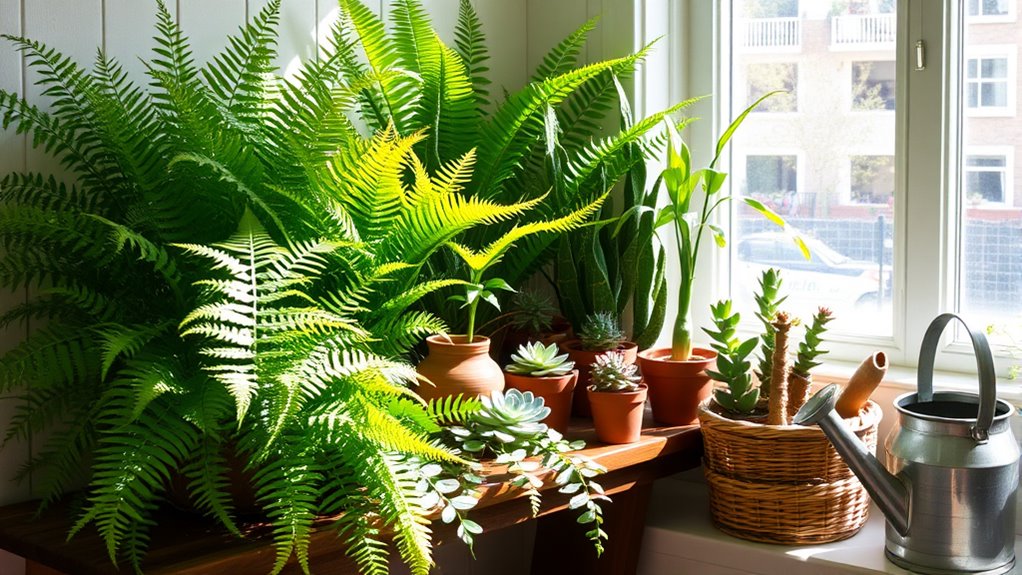Caring for your space boosts your mental, physical, and emotional health. You can improve indoor air quality by ventilating regularly, using air purifiers, and choosing low-emission products. Installing a whole-house water filtration system enhances your water’s safety and taste. Embracing sustainable practices like recycling, using eco-friendly materials, and incorporating native plants creates a healthier environment. Prioritizing these steps helps you thrive and protect your space, and exploring more tips will guide you toward a truly wellness-focused environment.
Key Takeaways
- Regularly ventilate your space to reduce indoor pollutants and improve air quality.
- Use air purifiers and choose low-emission products for a healthier indoor environment.
- Incorporate sustainable materials and native plants to support environmental health and local ecosystems.
- Implement water filtration systems to ensure clean, safe drinking water throughout your home.
- Adopt eco-friendly practices like recycling, conserving energy, and using renewable resources to promote overall wellness.

Have you ever considered how your environment impacts your overall well-being? It’s not just about the physical space you occupy but also the quality of the air you breathe and the choices you make to support sustainable living. Your environment plays a pivotal role in your mental, physical, and emotional health, so taking intentional steps to care for it can truly enhance your quality of life. One of the most immediate and noticeable aspects of environmental wellness is indoor air quality. Poor air quality can lead to a range of health issues, from allergies and asthma to fatigue and headaches. When your indoor spaces are filled with dust, mold, volatile organic compounds (VOCs), or other pollutants, it affects your ability to breathe comfortably and can weaken your immune system over time. Improving indoor air quality involves simple but effective actions, like regularly ventilating your home, using air purifiers, and choosing low-emission products. These small steps make a significant difference in creating a healthier environment for yourself and your loved ones. Additionally, understanding the importance of whole-house water filtration systems can further improve your indoor environment by providing cleaner, better-tasting water throughout your home.
Sustainable living also plays an essential role in nurturing your environment and, consequently, your overall wellness. When you adopt sustainable practices, you reduce your ecological footprint and foster a healthier planet, which in turn benefits your immediate surroundings. This can mean conserving energy by switching to energy-efficient appliances, reducing waste through recycling and composting, or opting for eco-friendly products. Sustainable living encourages mindfulness about how your daily choices impact the environment and empowers you to make more conscious decisions. For instance, using renewable energy sources like solar power not only lowers greenhouse gas emissions but also creates a quieter, cleaner, and safer home environment. When your space is aligned with sustainable principles, it feels more harmonious and balanced, which positively influences your mental health and sense of purpose.
Creating an environmentally wellness-oriented space goes beyond just individual actions. It involves fostering a mindset that values sustainability and recognizes the importance of caring for your surroundings. This might mean planting native plants to support local ecosystems or choosing furniture made from sustainable materials. These efforts not only improve your environment but also create a sense of connection and responsibility to the world around you. In the process, you become more aware of how your lifestyle choices ripple outward, influencing your health and the health of the planet. Prioritizing indoor air quality and embracing sustainable living aren’t just about protecting the environment—they’re about enriching your life, making your space more inviting, and ensuring that your environment supports your overall wellness every day.
Frequently Asked Questions
How Can I Improve Indoor Air Quality Effectively?
To improve indoor air quality, start by using indoor air filtration systems like HEPA filters to trap pollutants. Make certain your ventilation systems are working efficiently by regularly cleaning and maintaining vents and exhaust fans. Keep your space well-ventilated by opening windows when possible, and avoid smoking indoors. You can also reduce allergens and pollutants by controlling humidity levels and minimizing clutter that traps dust.
What Are Eco-Friendly Cleaning Products I Should Use?
You should choose eco-friendly cleaning products like biodegradable packaging options and non-toxic disinfectants. These products effectively clean your space without releasing harmful chemicals into the environment. Look for labels indicating biodegradable ingredients and non-toxic formulas to guarantee safety for your family and the planet. Using these alternatives helps reduce pollution, minimizes chemical exposure, and supports sustainability, making your home healthier and more eco-conscious.
How Does Decluttering Benefit Environmental Wellness?
Decluttering is like opening a window to fresh air, giving your space and mind clarity. It benefits your environmental wellness by reducing waste and making sustainable waste management easier. When you declutter, you’re more likely to use natural cleaning techniques and eco-friendly products, minimizing harmful chemicals. This process promotes a healthier environment, saves resources, and encourages mindful consumption, creating a space that’s both clean and eco-conscious.
What Plants Are Best for Purifying Indoor Air?
You should choose air purifying plants like snake plants, pothos, and peace lilies for indoor greenery. These plants effectively filter toxins such as formaldehyde, benzene, and carbon monoxide from your air, improving indoor air quality. Keep them in well-lit spots and water them regularly to maintain their health and purifying abilities. Incorporating these air purifying plants into your space creates a healthier, fresher environment for you to enjoy.
How Can I Reduce Energy Consumption at Home?
Imagine your home as a garden thriving with mindful choices. To reduce energy consumption, you should use energy-efficient appliances and switch to renewable energy sources like solar or wind power. These steps act as watering your garden wisely, fostering growth without waste. By making these changes, you’ll conserve resources, lower bills, and create a sustainable space where energy flows smoothly, supporting both your home and the planet.
Conclusion
Taking care of your environment isn’t just about cleanliness—it’s about fostering your overall well-being. When you create a healthy space, you reduce stress and boost your mood. Did you know that indoor air can be up to five times more polluted than outdoor air? By prioritizing environmental wellness, you’re not only protecting your surroundings but also nurturing your health and happiness every day. Start small, and watch your space—and life—transform.









